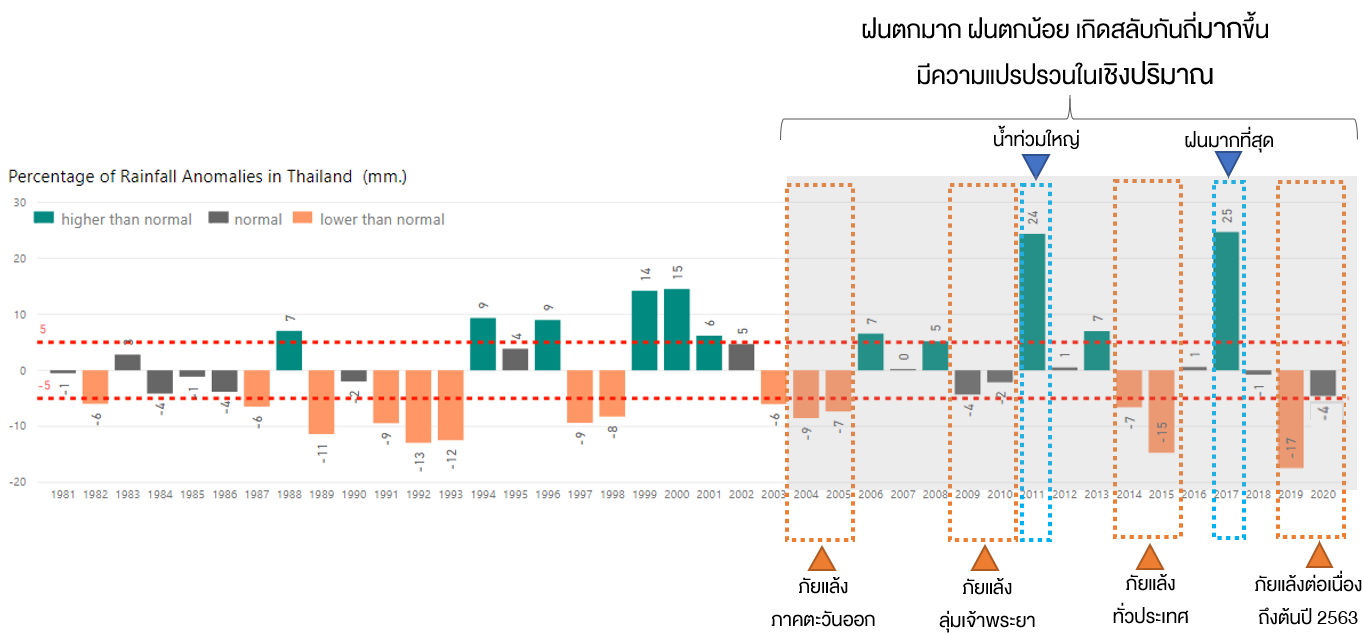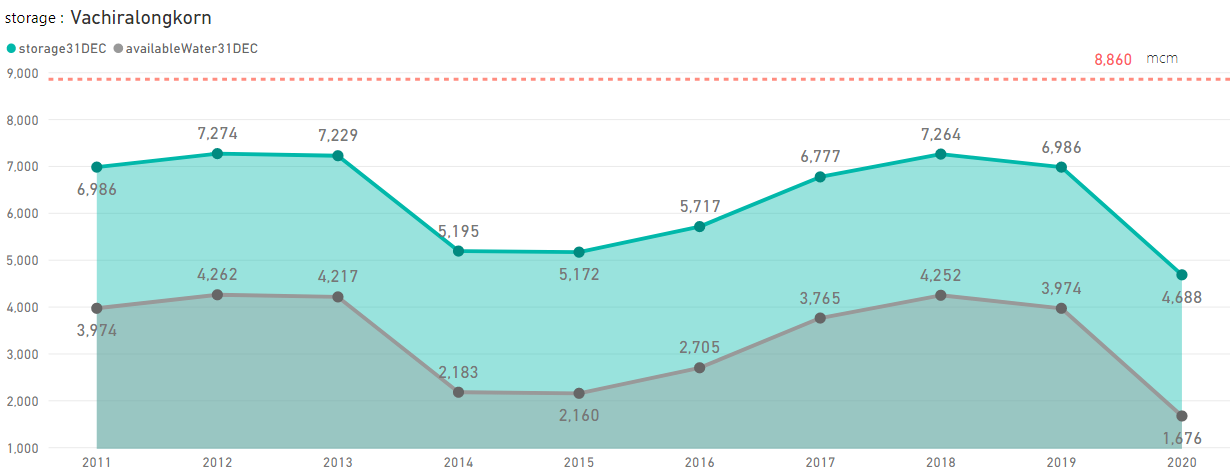ปี 2563 ประเทศไทยมีปริมาณฝนเฉลี่ยทั้งประเทศประมาณ 1,400 มิลลิเมตร น้อยกว่าปกติ 63 มิลลิเมตร หรือน้อยกว่าปกติประมาณ 4% ซึ่งเกิดขึ้นต่อเนื่องในช่วงเดือนมกราคมจนถึงเดือนกรกฎาคม และเกิดขึ้นอีกครั้งในเดือนกันยายนและพฤศจิกายน พื้นที่ส่วนใหญ่ของประเทศมีฝนตกน้อยกว่าปกติ โดยเฉพาะภาคเหนือที่มีฝนตกน้อยกว่าปกติเกือบทุกพื้นที่
ครอบคลุมไปปถึงภาคกลางตอนบนรวมถึงพื้นที่ส่วนใหญ่ของภาคตะวันออกเฉียงเหนือ และถึงแม้พื้นที่ส่วนใหญ่ของประเทศจะเกิดฝนตกน้อยกว่าปกติ แต่กลับมีบางพื้นที่เกิดฝนตกมากกว่าปกติค่อนข้างมาก โดยเฉพาะทางตอนล่างของภาคตะวันออกเฉียงเหนือที่เกิดฝนตกมากกว่าปกติครอบคลุมเป็นบริเวณกว้างในพื้นที่จังหวัดนครราชสีมา บุรีรัมย์ ชัยภูมิ ขอนแก่น โดยเฉพาะบริเวณ
เขาใหญ่รอยต่อของจังหวัดนครราชสีมาและปราจีนบุรีที่มีฝนตกมากกว่าบริเวณอื่นค่อนข้างมาก เนื่องจากได้รับอิทธิพลจากพายุและร่องมรสุมพาดผ่านในช่วงเดือนตุลาคม นอกจากนี้ภาคใต้ตั้งแต่จังหวัดสุราษฎร์ธานีลงไปมีฝนตกมากกว่าปกติเป็นบริเวณกว้างด้วยเช่นกัน
In 2020, Thailand had an average annual rainfall of 1,400 mm, which was 63 mm less than normal or approximately 4% lower than normal. Below-normal rainfall occurred continuously from January to July, and it occurred again in September and November. Most areas of the country experienced less rainfall than usual, especially in the northern region, where below-
normal rainfall covered almost all areas, as well as the upper central region and most areas of the northeastern region. Although most areas of the country experienced less rainfall than usual, some areas had quite much more rainfall than usual, especially in the lower northeastern region covering a wide area in Nakhon Ratchasima, Buriram, Chaiyaphum and Khon Khaen
provinces, and, in particular, Khaoyai National Park, the junction of Nakhon Ratchasima and Prachin Buri provinces, where rainfall was relatively more than other areas due to the influence of a storm and monsoon troughs in October. Moreover, the southern region from Surat Thani Province down also experienced more rainfall than usual in a wide area.


จากสถิติข้อมูลฝนรายปีย้อนหลังในรอบ 40 ปี ชี้ให้เห็นได้ว่าในช่วง 10 -15 ปีที่ผ่านมา ปริมาณฝนของประเทศไทยมีความแปรปรวนค่อนข้างสูง ความถี่ของการเกิดฝนตกน้อยกว่าปกติเกิดสลับกันกับฝนตกมากกว่าปกติมีเพิ่มมากขึ้น เหตุการณ์
น้ำท่วมรุนแรงและภัยแล้งรุนแรงเกิดสลับกันบ่อยครั้งขึ้น โดยภัยแล้งครั้งล่าสุดเริ่มเกิดขึ้นมาตั้งแต่ช่วงกลางปี 2561 ต่อเนื่องมาถึงปี 2562 ที่ฝนตกน้อยกว่าปกติถึง 17% และยังคงเกิดขึ้นต่อเนื่องมาถึงช่วงปี 2563 ที่ถึงแม้ปริมาณฝนในภาพรวมทั้ง
ประเทศจะต่ำกว่าปกติเพียงเล็กน้อยเท่านั้น เนื่องจากเกิดฝนตกมากกว่าปกติในบางพื้นที่ แต่พื้นที่ส่วนใหญ่กลับมีฝนตกน้อยกว่าปกติ โดยเฉพาะพื้นที่ตอนบนของประเทศทั้งภาคเหนือ ภาคกลาง และภาคตะวันออกเฉียงเหนือ
The statistics of annual rainfall data in the past 40 years revealed that the variability of rainfall in Thailand was quite high over the past 10-15 years. The frequency of below-normal rainfall occurrence alternating with above-normal rainfall increased, and this caused
severe flooding and severe drought to alternate more often as well. The latest drought started in mid-2018 and continued to 2019, where rainfall was 17% less than normal. It continued into the year 2020 despite the amount of rainfall in the whole country was only slightly
lower than normal due to more rain than usual in some areas, but most areas of the country had less rainfall than normal, especially in upper Thailand including the northern, central, and northeastern regions.

พายุเป็นหนึ่งในปัจจัยสำคัญที่ทำให้เกิดฝนตกมากหรือฝนตกน้อยในประเทศไทย ปี 2563 มีพายุเคลื่อนตัวเข้าสู่ประเทศไทยจำนวน 3 ลูก เป็นพายุโซนร้อน 1 ลูก และพายุดีเปรสชัน 2 ลูก โดยพายุลูกแรกที่เคลื่อนเข้าสู่ประเทศไทยคือพายุโซนร้อน “ซินลากู” (SINLAKU) ที่เคลื่อนเข้าสู่ประเทศไทยบริเวณจังหวัดน่าน ในขณะที่มีกำลังแรงอยู่ในระดับพายุดีเปรสชัน ส่งผลทำให้มีฝนตกหนักถึงหนักมากในหลายพื้นที่ของภาคเหนือและบางพื้นที่ของภาค
ตะวันออกเฉียงเหนือในช่วงต้นเดือนสิงหาคม ส่วนลูกที่สองคือพายุโซนร้อน “โนอึล” (NOUL) ที่เคลื่อนเข้าสู่ประเทศไทยบริเวณจังหวัดมุกดาหาร ในขณะที่มีกำลังแรงอยู่ในระดับพายุโซนร้อน ส่งผลทำให้มีฝนตกหนักถึงหนักมากบริเวณตอนล่างของภาคตะวันออกเฉียงเหนือและภาคเหนือในช่วงเดือนกันยายน ลูกที่สามคือพายุไต้ฝุ่น “โมลาเบ” (MOLAVE) ที่เคลื่อนเข้าสู่ประเทศไทยบริเวณจังหวัดอุบลราชธานี ในขณะที่มีกำลังแรงอยู่ในระดับพายุดีเปรสชัน
ส่งผลทำให้มีฝนตกเพิ่มมากขึ้นทางตอนล่างของภาคตะวันออกเฉียงเหนือในช่วงปลายเดือนตุลาคม นอกจากพายุทั้ง 3 ลูกที่กล่าวมาแล้วข้างต้น ประเทศไทยยังได้รับอิทธิพลจากพายุอีก 9 ลูก ที่ถึงแม้จะไม่ได้เคลื่อนตัวเข้าสู่ประเทศไทย แต่พายุดังกล่าวได้อ่อนกำลังลงเป็นหย่อมความกดอากาศต่ำก่อนเคลื่อนเข้าปกคลุมบริเวณประเทศไทยหรืออ่อนกำลังลงเป็นหย่อมความกดอากาศต่ำบริเวณประเทศเพื่อนบ้าน ซึ่งส่งผลทำให้ประเทศไทยมีปริมาณฝนเพิ่มมากขึ้น
Storms are one of the major factors causing more or less rainfall in Thailand. In 2020, there were 3 storms moving into Thailand, one tropical storm and two depressions. The first storm was the tropical storm “SINLAKU” that moved into Thailand in Nan Province while it was a depression, and it caused heavy to very heavy rain in many areas of the northern region and some parts of the northeastern region in early
August. The second storm was the tropical storm “NOUL” that moved into Thailand in Mukdahan Province while it was a tropical storm causing heavy to very heavy rain in the lower northeastern region and the northern region during September. The third storm was the typhoon “MOLAVE” that moved into Thailand in Ubon Ratchathani Province while it was a depression. It caused more rain in the lower northeastern region in late
October. In addition to the three storms mentioned above, Thailand was also influenced by 9 more storms that did not move directly into Thailand, but they had weakened into low-pressure cells before moving to cover Thailand, or they decayed in neighboring countries, which resulted in more rain in Thailand.


จากปัจจัยต่าง ๆ ไม่ว่าจะเป็นพายุหรือร่องมรสุมก็ตาม ส่งผลให้ในปี 2563 เกิดสถานการณ์น้ำท่วมเกิดขึ้นในช่วงเดือนสิงหาคมถึงกันยายน ซึ่งมีพื้นที่ถูกน้ำท่วมประมาณ 2 ล้านไร่ ในพื้นที่ 42 จังหวัด 297 อำเภอ 1,606 ตำบล พื้นที่ถูกน้ำท่วมส่วนใหญ่เกิดขึ้นที่บริเวณภาคตะวันออก
เฉียงเหนือ โดยจังหวัดนครราชสีมา เป็นจังหวัดที่มีพื้นที่ถูกน้ำท่วมมากที่สุด 320,004 ไร่ รองลงมาคือจังหวัดนครศรีธรรมราช ที่มีพื้นที่ถูกน้ำท่วม 259,053 ไร่ หากเทียบพื้นที่ถูกน้ำท่วมของปี 2563 กับปีอื่น ๆ ในอดีตตั้งแต่ปี 2548 - 2562 จะเห็นได้ว่า ปี 2563 มีพื้นที่ถูก
น้ำท่วมค่อนข้างน้อยเมื่อเทียบกับปีอื่น ๆ โดยมีพื้นถูกน้ำท่วมน้อยเป็นอันดับ 2 รองจากปี 2558 ซึ่งเป็นปีที่ประเทศไทยเกิดภัยแล้งรุนแรง (พื้นที่น้ำท่วมเป็นการวิเคราะห์จากภาพถ่ายดาวเทียม)
Those factors, whether it be storms or monsoon troughs, caused floods that occurred during August to September 2020 with a total flooded area of about 2 million rai in 42 provinces, 297 districts, and 1,606 sub-districts. Most of the flooded areas were in the
northeastern region, where Nakhon Ratchasima is the province with the largest flooded area of 320,004 rai, followed by Nakhon Si Thammarat Province which had a total flooded area of 259,053 rai. There were relatively few flooded areas in 2020
when compared with other years during 2005-2019. The year 2020 had the second lowest flooded area after 2015 which was the year of severe drought in Thailand. (The flooded areas were analyzed from satellite imageries).


ถึงแม้ฝนที่ตกในปีนี้จะทำให้เกิดน้ำท่วมหลายพื้นที่ และหลายเขื่อนมีน้ำเพิ่มมากขึ้นไม่ว่าจะเป็นภาคตะวันออกเฉียงเหนือ ภาคตะวันออก และภาคใต้ แต่ปริมาณน้ำไหลลงเขื่อนรวมทั้งปีกลับมีอยู่เพียง 27,438 ล้านลูกบาศก์เมตร น้อยกว่าปี 2562 ที่ประเทศไทยประสบปัญหาภัยแล้งอยู่ 1,916 ล้านลูกบาศก์เมตร ซึ่งส่งผลทำให้น้ำกักเก็บคงเหลือสิ้นปีสำหรับเป็นต้นทุนน้ำในปี 2564 มีเพียง 43,153 ล้านลูกบาศก์เมตร หรือคิดเป็น 61% ของความจุเขื่อน อยู่ใน
เกณฑ์น้ำปานกลาง ซึ่งน้อยกว่าปี 2562 อยู่ 1,130 ล้านลูกบาศก์เมตร ทั้งนี้เนื่องจากเขื่อนในภาคเหนือซึ่งเป็นเขื่อนสำคัญของลุ่มน้ำเจ้าพระยาที่จะต้องส่งน้ำลงมายังพื้นที่ภาคกลาง มีน้ำกักเก็บเหลืออยู่ค่อนข้างน้อย ประกอบกับเขื่อนในพื้นที่ภาคกลางมีน้ำกักเก็บคงเหลือน้อยมากด้วยเช่นกัน โดยในปีนี้เขื่อนศรีนครินทร์และเขื่อนวชิราลงกรณ ที่ตั้งอยู่ทางด้านตะวันตกของภาคกลางในพื้นที่ลุ่มน้ำแม่กลอง ซึ่งโดยปกติแล้ว หากลุ่มน้ำเจ้าพระยาเกิดการขาดแคลนน้ำ จะมี
การผันน้ำจากสองเขื่อนดังกล่าวเพื่อเข้ามาช่วยบรรเทาสถานการณ์บริเวณภาคกลางตอนล่างได้ในบางพื้นที่ แต่ในปีนี้ปริมาณน้ำใช้การได้ของทั้งสองเขื่อนเหลือน้อยมาก โดยเฉพาะเขื่อนวชิราลงกรณที่มีน้ำเหลือน้อยที่สุดในรอบ 10 ปี ส่วนเขื่อนศรีนครินทร์ปริมาณน้ำเหลือน้อยมากเช่นกัน แต่ยังมากกว่าช่วงปี 2557-2558 อยู่เล็กน้อย ด้วยเหตุนี้อาจทำให้มีน้ำไม่เพียงพอที่จะผันไปยังลุ่มน้ำเจ้าพระยาเพื่อช่วยบรรเทาสถานการณ์ได้
Although this year’s rain had caused floods in many areas, and many dams had more water, whether in the northeastern, eastern, or south regions, the total annual inflow water was only 27,438 million cubic meters (mcm). This was 1,916 mcm less than last year when Thailand faced a severe drought. As a result, stored water at the end of this year used as a water budget in 2021 was only 43,153 mcm or 61% of dam
capacity, which was the moderate level and was less than the year 2019 by 1,130 mcm. Moreover, dams in the northern region, which delivered water to the central region, had little stored water. In case of water shortage situation in the central region, the Srinagarind and Vajiralongkorn dams located in the west part of the region will divert water to mitigate the situation in some areas of the lower central
region. For this year, the amount of usable water from both dams was very low. In particular, the Vajiralongkorn Dam had the lowest stored water in the past 10 years, while the Srinagarind Dam had very little stored water as well, but still slightly more than the period 2014-2015. Therefore, there might not be enough water to divert to the lower central region to help alleviate the situation.

